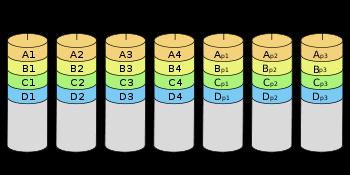Asked By
45peeter
0 points
N/A
Posted on - 09/30/2011

When we talking about the RAID (RedundantArray of Independent Disks), when learning about the RAID level 2 there was party called Hamming-party. What is mean by the Hamming-party and how it will help to make disk spindle rotation is synchronized?
Hamming code in Redundant Array of Independent Disks

RAID2 stripes data at the bit level. Richard Hamming develop Hamming Code for error correction. The Disks are Synchronized by the controller to spin at the same angular orientation. Means they reach index at the same time. Due to this, Extremely high data transfer rates are possible.
Using Hamming Code errors are corrected. It Consists of four data bits and three parity bits. It also permits 7 disks, four are used for data storage and three are used for error correction. Other RAIDs can detect single-bit corruption in data but can not resolve contradictions between parity bit and data bit without human interaction. In RAID2, data is strongly protected from corruption. Hamming Code Algorithm is used to check bytes for errors and also it is responsible to allow drive controller to rebuild data in its original form.
Finally, RAID2 is now the part of computing technology.

Hamming code in Redundant Array of Independent Disks

A Hamming code is a set or group of error-correction codes named after R. W. Hamming of Bell Labs that can be used to detect and correct bit errors that can happen when data is stored or moved.
The Hamming code, like other error-correction code, uses the concept of parity and parity bits which are bits added to data so that the data’s validity can be checked when it is read or after the data has been received in a data transmission.
An error-correction code, using more than one parity bit, not only can it identify a single bit error in the data unit but also its location in the data unit. FEC or Forward Error Correction, in data transmission, is the capacity of a receiving station to correct errors in the received data.
It can also raise the throughput on a data link when there is a lot of noise present. To make this possible, a transmitting station must add extra data or what they call “error correction bits” to the transmission.













